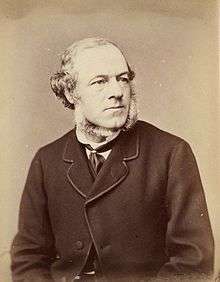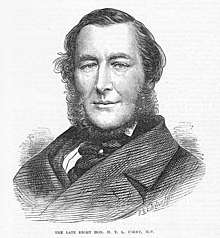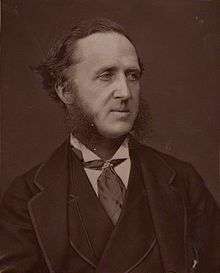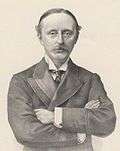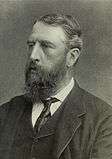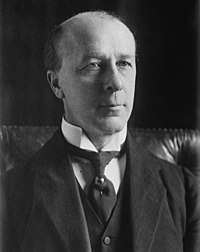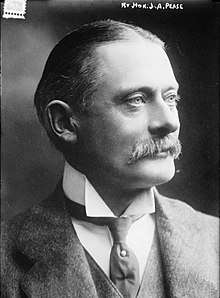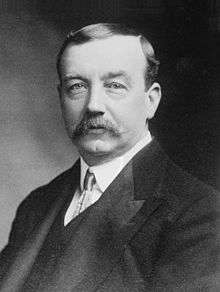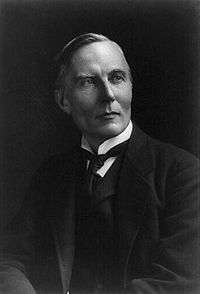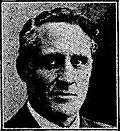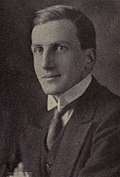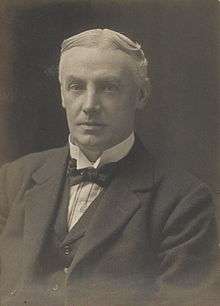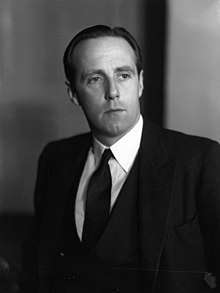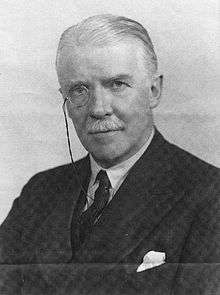Secretary of State for Education
The Secretary of State for Education, also referred to as the Education Secretary, is a senior Minister of the Crown within the Government of the United Kingdom, and head of the Department for Education. The office forms part of the British Cabinet.
| Her Majesty's Principal Secretary of State for Education | |
|---|---|
.svg.png) | |
| Department for Education | |
| Style | Education Secretary (informal) The Right Honourable (UK and the Commonwealth) |
| Status | Minister of the Crown |
| Member of | Cabinet Privy Council |
| Reports to | The Prime Minister |
| Seat | Westminster |
| Appointer | The Crown on advice of the Prime Minister |
| Term length | At Her Majesty's Pleasure |
| Formation | 10 April 1992 |
| First holder | William Cowper-Temple as Committee of the Council on Education (5 February 1857) John Patten as Secretary of State for Education |
| Website | www.gov.uk |
The current Secretary of State for Education is Gavin Williamson, MP since his appointment by Prime Minister Boris Johnson, in July 2019.
Responsibilities
Corresponding to what is generally known as an education minister in many other countries, the Education Secretary's remit is concerned primarily with England. This includes:
- Oversight of the national curriculum
- Management of academies, free schools, early years, apprenticeships, further education and higher education
- Management of teacher recruitment and pay
- Oversight of school infrastructure improvement[1]
History
A committee of the Privy Council was appointed in 1839 to supervise the distribution of certain government grants in the education field. The members of the committee were the Lord President of the Council, the Secretaries of State, the First Lord of the Treasury, and the Chancellor of the Exchequer. From 1857 a vice-president was appointed who took responsibility for policy.
On 1 April 1900, the Board of Education Act 1899 abolished the committee and instituted a new board, headed by a president. The members were initially very similar to the old committee and the president of the board was the Lord President of the Council; however, from 1902 this ceased to be the case and the president of the board was appointed separately (although the Marquess of Londonderry happened to hold both jobs from 1903 to 1905).
The Education Act 1944 replaced the Board of Education with a new Ministry of Education.
The Department of Education and Science was created in 1964 with the merger of the offices of Minister of Education and the Minister of Science.
In 1992, the responsibility for science was transferred to Cabinet Office's Office of Public Service, and the department was renamed Department of Education. In 1995 the department merged with the Department of Employment to become the Department for Education and Employment (DfEE) and in 2001 the employment functions were transferred to a newly created Department for Work and Pensions, with the DfEE becoming the Department for Education and Skills (DfES). In 2007 under Gordon Brown's new premiership, the DfES was split into two new departments; the Department for Children, Schools and Families, and a Department for Innovation, Universities and Skills, under two new secretaries of state.
The ministerial office of the Secretary of State for Innovation, Universities and Skills was, in late 2009, amalgamated into the new ministerial office of the resurgent politician Peter Mandelson, made a peer and given the title Lord Mandelson as the newly created Secretary of State for Business, Innovation and Skills – itself an amalgamation of the responsibilities of the Secretaries of State for Business, Enterprise and Regulatory Reform and Innovation, Universities and Skills. The Secretary of State has remit over higher education policy as well as British business and enterprise. From 14 July 2016 to January 8, 2018 the post was held by Justine Greening, as her predecessor, Nicky Morgan, was sacked by Theresa May. Greening resigned after rejecting a reshuffle to the Department for Work and Pensions. [2]
List of office holders
Vice-President of the Committee of the Council on Education
Colour key (for political parties):
Whig
Conservative
Liberal
President of the Board of Education
Colour key (for political parties):
Liberal Unionist
Conservative
Liberal
Labour
National Labour
Minister of Education
Colour key (for political parties):
Conservative
Labour
| Name | Portrait | Term of office | Party | Prime Minister | |||
|---|---|---|---|---|---|---|---|
| R. A. Butler | 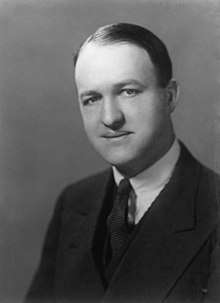 |
3 August 1944 | 25 May 1945 | Conservative | Winston Churchill (War Coalition) | ||
| Richard Law | 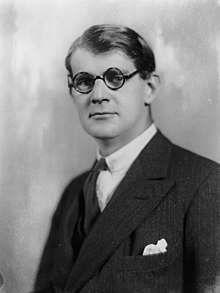 |
25 May 1945 | 26 July 1945 | Conservative | Winston Churchill (Caretaker Min.) | ||
| Ellen Wilkinson | 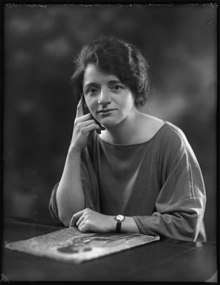 |
3 August 1945 | 6 February 1947 (died in office) |
Labour | Clement Attlee | ||
| George Tomlinson | 10 February 1947 | 26 October 1951 | Labour | ||||
| Florence Horsbrugh | 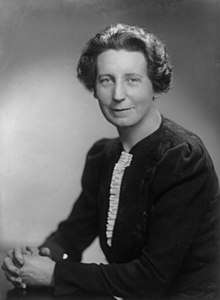 |
2 November 1951 | 18 October 1954 | Conservative | Sir Winston Churchill | ||
| David Eccles |  |
18 October 1954 | 13 January 1957 | Conservative | |||
| Sir Anthony Eden | |||||||
| The Viscount Hailsham |  |
13 January 1957 | 17 September 1957 | Conservative | Harold Macmillan | ||
| Geoffrey Lloyd | 17 September 1957 | 14 October 1959 | Conservative | ||||
| David Eccles |  |
14 October 1959 | 13 July 1962 | Conservative | |||
| Sir Edward Boyle, Bt | 13 July 1962 | 1 April 1964 | Conservative | ||||
| Sir Alec Douglas-Home | |||||||
Secretary of State for Education and Science
Colour key (for political parties):
Conservative
Labour
| Name | Portrait | Term of office | Party | Prime Minister | |||
|---|---|---|---|---|---|---|---|
| Quintin Hogg (formerly Viscount Hailsham) |
 |
1 April 1964 | 16 October 1964 | Conservative | Sir Alec Douglas-Home | ||
| Michael Stewart | .jpg) |
18 October 1964 | 22 January 1965 | Labour | Harold Wilson | ||
| Anthony Crosland |  |
22 January 1965 | 29 August 1967 | Labour | |||
| Patrick Gordon Walker |  |
29 August 1967 | 6 April 1968 | Labour | |||
| Edward Short | 6 April 1968 | 19 June 1970 | Labour | ||||
| Margaret Thatcher | 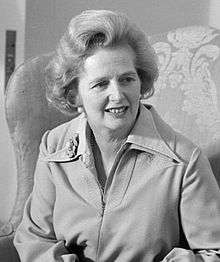 |
20 June 1970 | 4 March 1974 | Conservative | Edward Heath | ||
| Reginald Prentice | 5 March 1974 | 10 June 1975 | Labour | Harold Wilson | |||
| Fred Mulley | 10 June 1975 | 10 September 1976 | Labour | ||||
| James Callaghan | |||||||
| Shirley Williams | 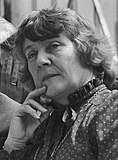 |
10 September 1976 | 4 May 1979 | Labour | |||
| Mark Carlisle | 5 May 1979 | 14 September 1981 | Conservative | Margaret Thatcher | |||
| Sir Keith Joseph, Bt | 14 September 1981 | 21 May 1986 | Conservative | ||||
| Kenneth Baker |  |
21 May 1986 | 24 July 1989 | Conservative | |||
| John MacGregor | 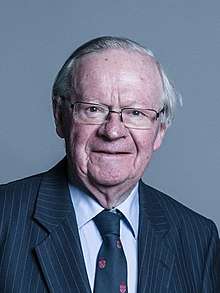 |
24 July 1989 | 2 November 1990 | Conservative | |||
| Kenneth Clarke |  |
2 November 1990 | 10 April 1992 | Conservative | |||
| John Major | |||||||
Secretary of State for Education
Colour key (for political parties):
Conservative
| Name | Term of office | Party | Prime Minister | |||
|---|---|---|---|---|---|---|
| John Patten | 10 April 1992 | 20 July 1994 | Conservative | John Major | ||
| Gillian Shephard | 20 July 1994 | 5 July 1995 | Conservative | |||
Secretary of State for Education and Employment
Colour key (for political parties):
Conservative
Labour
| Name | Portrait | Term of office | Party | Prime Minister | |||
|---|---|---|---|---|---|---|---|
| Gillian Shephard | 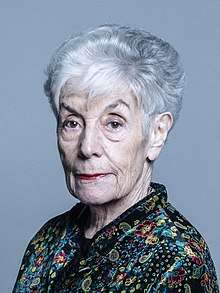 |
5 July 1995 | 2 May 1997 | Conservative | John Major | ||
| David Blunkett |  |
2 May 1997 | 8 June 2001 | Labour | Tony Blair | ||
Secretary of State for Education and Skills
Colour key (for political parties):
Labour
| Name | Portrait | Term of office | Party | Prime Minister | |||
|---|---|---|---|---|---|---|---|
| Estelle Morris |  |
8 June 2001 | 24 October 2002 (resigned) |
Labour | Tony Blair | ||
| Charles Clarke |  |
24 October 2002 | 15 December 2004 | Labour | |||
| Ruth Kelly |  |
15 December 2004 | 5 May 2006 | Labour | |||
| Alan Johnson | 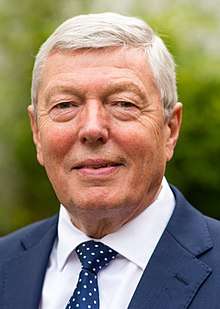 |
5 May 2006 | 27 June 2007 | Labour | |||
Secretaries of State for Children, Schools and Families; and Innovation, Universities and Skills
In 2007, the education portfolio was divided between the Department for Children, Schools and Families (responsible for infant, primary and secondary education), and the Department for Innovation, Universities and Skills (responsible for further, higher and adult education). In 2009, the latter department was merged into the Department for Business, Innovation and Skills.
Colour key (for political parties):
Labour
Labour Co-operative
| Sec.State for Children, Schools and Families |
Sec.State for Innovation, Universities and Skills |
Term of office | Party | Prime Minister | ||||||
|---|---|---|---|---|---|---|---|---|---|---|
| Ed Balls | 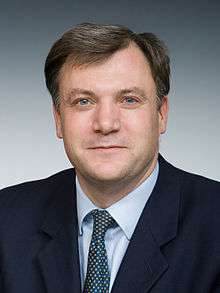 |
John Denham |  |
28 June 2007 | 5 June 2009 | Labour Labour Co-op (Balls) |
Gordon Brown | |||
| Post abolished; duties transferred to Sec.State for Business, Innovation and Skills. |
5 June 2009 | 11 May 2010 | ||||||||
Secretary of State for Education
The Department for Education and the post of Secretary of State for Education were recreated in 2010.
Responsibility for higher and adult education remained with the Secretary of State for Business, Innovation and Skills (Vince Cable 2010–2015, Sajid Javid 2015–2016), until reunited with the Department for Education in 2016.
Colour key (for political parties):
Conservative
| Name | Portrait | Term of office | Party | Prime Minister | |||
|---|---|---|---|---|---|---|---|
| Michael Gove |  |
11 May 2010 | 15 July 2014 | Conservative | David Cameron (Coalition) | ||
| Nicky Morgan | 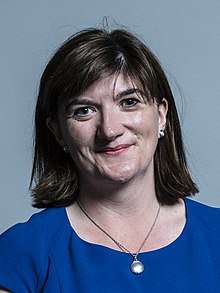 |
15 July 2014 | 14 July 2016 | Conservative | |||
| David Cameron (II) | |||||||
| Justine Greening | 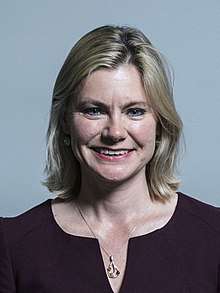 |
14 July 2016 | 8 January 2018 | Conservative | Theresa May (I) | ||
| Theresa May (II) | |||||||
| Damian Hinds |  |
8 January 2018 | 24 July 2019 | Conservative | |||
| Gavin Williamson | 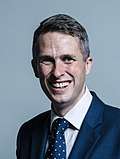 |
24 July 2019 | Incumbent | Conservative | Boris Johnson (I & II) | ||
References
- https://www.gov.uk/government/ministers/secretary-of-state-for-education
- "Reshuffle: Greening quits government". BBC News. Retrieved 8 January 2018.
- "No. 27172". The London Gazette. 9 March 1900. p. 1609.
External links
| Wikimedia Commons has media related to Secretaries of State for Education of the United Kingdom. |




